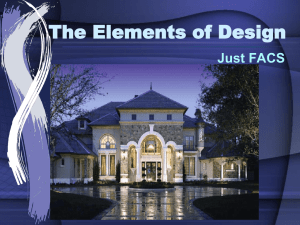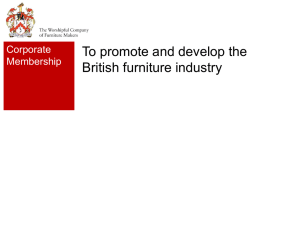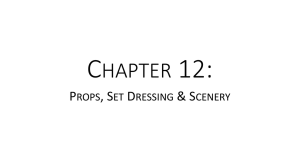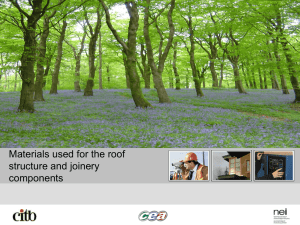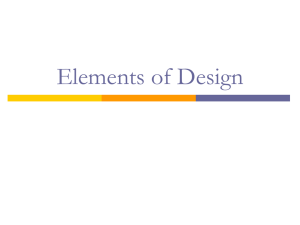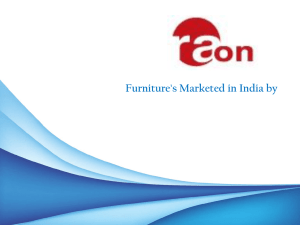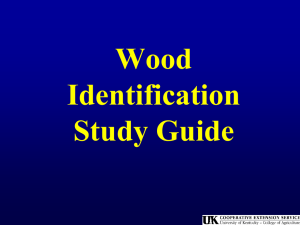Wood Identification Powerpoint
advertisement
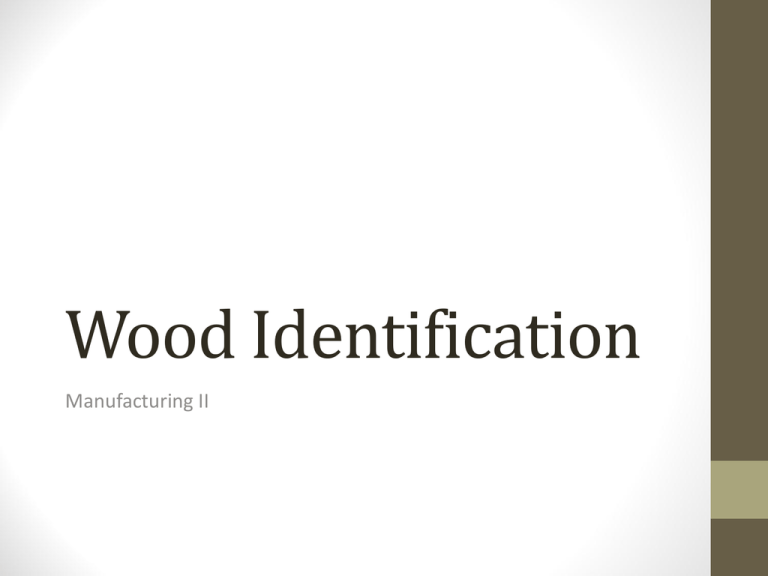
Wood Identification Manufacturing II Grain • The mass of the wood’s cell structure. • Determined by the growth of a tree. • Straight, Cross, Spiral, Curly Sawing • With the grain (length) • Across the grain (width) Figure • • • • • Describes the appearance of the wood Density of the annual growth rings Size and shape of the rings Distribution of color Effect of disease or physical damage http://www.wurrkshopwoods.com/types-of-wood.htm Texture • Relative size of the woods cells • Fine texture woods have small closely spaced cells • Course textured woods have large cells • Affects the cutting process • Appearance after staining and finish Hardwoods Deciduous Broad leaved trees Loss of leaves in the winter More durable than softwoods Wider choice of color, texture, and figure More expensive than softwoods Walnut Hardwood Tough wood Coarse texture Usually straight grain Rich dark brown to purplish black color Good workability Good finishing Furniture, gunstocks, instruments Cherry • Hardwood • Hard • Straight grained • Fine texture • Heartwood is reddish brown to deep red • Good workability • Good finishing • Furniture, instruments, flooring Poplar • Hardwood • Soft and light weight • Straight grain • Fine texture • White sapwood, pale olive green to brown heartwood • Good workability • Good finishing • Furniture, toys Mahogany Hardwood Medium textured Straight even grain Heartwood is reddish brown to deep red blonde highlights Good workability Good finishing Interior paneling, carving, furniture Maple • Hardwood • Hard, heavy • Straight grain • Fine texture • White sapwood with reddish brown heartwood • Difficult workability • Fair finishing • Furniture, instruments, butcher blocks Balsa • Softest and lightest commercial hardwood • Open straight grain • Very pale beige to pinkish color • Good workability • Fair finishing • Models, packaging White Oak • Hardwood • Straight grained • Course texture • Brown in color • Good workability • Good finishing • Furniture, flooring Red Oak • Hardwood • Straight grained • Course texture • Pinkish Red in color • Good workability • Good finishing • Furniture, flooring Chestnut • Course textured with wide growth rings. • Similar to oak in appearance • Because of blight most lumber comes from standing dead wood trees. • Insect attack causes “wormy chestnut” • Furniture, coffins, poles, stakes • Good finishing Birch • Hardwood • Fine grain • Pale tan with light brown growth rings • Good workability, Good finishing • Dowels, knobs, turning projects Purpleheart • Hardwood • Uniform fine to medium texture • Usually straight grained • Attractive purple color • Medium workability • Good finishing • Construction work, boats, furniture Softwoods • Coniferous Trees • Cone bearing trees • Evergreen • Narrow, needle shaped leaves • Light color range, pale yellow to reddish brown White Pine • Softwood • Straight grain • Fine even textured • Inconspicuous growth rings • Pale yellow to pale brown color • Good workability • Good finishing • Furniture, plywood Cedar • Softwood • Fine textured • Visible growth rings • Pale yellow to dark brown color • Good workability • Good finishing • Paneling, closets, hope chests Composite • Laminated material made from thin sheets of wood • Bonded in layers to form a thick stable board • Deteriorate when wet • Good workability • Fair finishing • Sub flooring, furniture Plywood • Hardwood, Softwood • Laminated layers of wood and glue pressed together to make a firm stable board • Warps when wet • Used for subflooring, furniture, roofing • Can be pressure treated Oriented Strand Board (OSB) • Hardwood or Softwood • Strands of wood in layers laminated with layers of glue and then pressed together. • Warps when wet • Used in construction subflooring, roofing, siding. • Used as a filler with veneer and Formica. Medium Density Fiber Board (MDF) • Hardwood or Softwood • Particles or saw dust fibers mixed with glue and pressed together. • Disintegrates when wet • Used in construction, sub woofer boxes, table tops Formica • OSB board coated in a Plastic sheet • Used in commercial and residential construction • Tabletops, Countertops, bathroom vanities • Is water proof on the top and sides cannot get wet on the bottom Veneer • Thin layer of wood used to cover types of composite wood. • Used for desktops, bookshelves, cheaper made furniture. • Pliable when wet with glue. • Special technique to apply.
